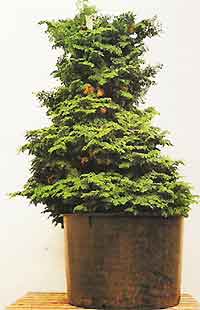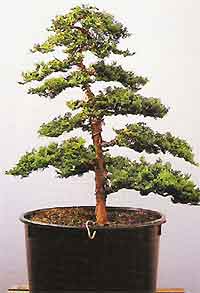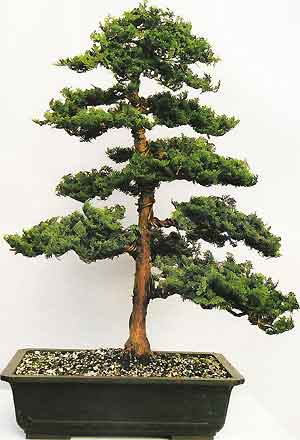Bonsai Trees
Case Histories
Hinoki Cypress - (chamaecyparis obtusa kosterei)
Hinoki Cypress Bonsai Style: Informal Upright

One Sunday afternoon I was driving to a large aquatic centre which is situated some 20 miles or so from my home. I often paid a visit there to get inspiration for my koi pond, which I intended building as soon as time permitted. On this particular occasion, in the middle of summer, I stopped off at a garden centre which was en route. Over the years I had visited this garden centre many times, but only ever purchasing plants and sundries, never being fortunate enough to spot any potential bonsai material.
I walked around the outside display area, carefully searching, when I noticed a large garden specimen hinoki cypress in the rockery section. I was not too excited at first, as I have seen many similar hinokis (variety 'nana gracilis') that contain large unsightly basal swellings as the result of grafts and are therefore not suitable for bonsai. I looked at the label and was intrigued as I was not familiar with this variety - 'kosterei'. On examining the trunk I was surprised to find no such swellings and began to dig around the base with my fingers, expecting to find an ugly graft hidden under the soil. However the buttress and root flair were quite the opposite, being nicely proportioned. The trunk was solid and pleasantly shaped.

Furthermore the branches were evenly distributed and I began to visualise what this tree could look like with styling and thinning. I decided that I had made quite a find with this hinoki and purchased it, smiling to myself as I loaded it into my car. Needless to say, I never reached the aquatic centre that day and headed straight for home, where I spent a long time styling the tree the following day. Whilst working on the tree I began to think about my good fortune in discovering this hinoki cypress.
Having visited the garden centre only several months before, I knew that it was new stock and must have been purchased from a wholesale nursery where possibly many more such trees existed. What an exciting thought! I rang the garden centre, explaining about my recent purchase and asked whether it would be possible for them to get similar trees, stressing that I did not definitely want the trees without seeing them first and may well reject them if they were not suitable for my purposes. They agreed to obtain more and so five were ordered and would be put to one side for my examination in two weeks time.

A fortnight later I visited the garden centre once more and was directed to the area where the trees had been placed for my perusal. The member of staff who was accompanying me thought that I would be able to decide immediately whether or not I wanted them and so waited closely behind me. When I realised he was waiting I explained that I may well be a while as I wanted to have a thorough look at them before I made my decision. He gave me a strange look and told me to choose whatever I wanted, leaving me on my own. I immediately discarded the first two trees. They were both made up of several thin trunks with poor bases and appeared much younger than the hinoki I had purchased before.
I began to feel somewhat despondent, but carried on looking at the others. The next tree had much more to offer. It had two trunks with the second, smaller trunk joining at the well developed base. Thinking that it had the potential to be a good twin trunk it was selected and put to one side whilst I carried on looking at the remaining two trees. The fourth tree was too sparse for bonsai training, but the fifth one however had good, well placed branches and a tapering, single trunk, displaying attractive curves. I had found two new hinokis that showed real promise.
When I arrived home, I lined up my two new trees next to my existing hinoki and spent time considering the many possibilities that these trees presented. I decided that it would be an interesting project to style them quite differently, so that I would end up with three very individual and unique trees, although when first purchased it was difficult to tell them apart as they merely looked like bushes of thick green foliage with no visible trunks.
Hinoki Cypress Bonsai History: Training
This was the first hinoki that I had purchased. After my usual photographic session, work began. The front was identified by a combination of trunk shape, root flair and main branch positions. These were all most promising at one particular angle and so the front was easily selected and I pushed a wire peg into the soil as a marker. Next I removed by pruning, everything that I knew was unnecessary, poor or dead branches and twigs, and foliage that was definitely not in a useful place.
This is a good method to adopt when styling raw material because the remaining tree can be viewed much more easily. My next step was to start work on each branch, working my way up from the bottom. The main branch had much die back in the centre and this was remedied by wiring foliage from other parts of the branch into this bare area. Each individual branch and shoot was wired and carefully positioned. Slowly the tree began to take shape. As I became more familiar with the tree it was obvious that many branches were not needed, and these were pruned off as I went. The top of this hinoki had several heavy branches which were removed to leave a much finer structure and this was shaped to create a strong crown.
When wiring and basic styling was complete, the tree was finalised by adjusting any branches that I had knocked whilst wiring others and making sure that each branch related well as a whole. I was delighted with the result, which was certainly going to become a very powerful informal upright bonsai. The tree remained in the flower pot for the rest of the season.
 One Sunday afternoon I was driving to a large aquatic centre which is situated some 20 miles or so from my home. I often paid a visit there to get inspiration for my koi pond, which I intended building as soon as time permitted. On this particular occasion, in the middle of summer, I stopped off at a garden centre which was en route. Over the years I had visited this garden centre many times, but only ever purchasing plants and sundries, never being fortunate enough to spot any potential bonsai material.
One Sunday afternoon I was driving to a large aquatic centre which is situated some 20 miles or so from my home. I often paid a visit there to get inspiration for my koi pond, which I intended building as soon as time permitted. On this particular occasion, in the middle of summer, I stopped off at a garden centre which was en route. Over the years I had visited this garden centre many times, but only ever purchasing plants and sundries, never being fortunate enough to spot any potential bonsai material. Furthermore the branches were evenly distributed and I began to visualise what this tree could look like with styling and thinning. I decided that I had made quite a find with this hinoki and purchased it, smiling to myself as I loaded it into my car. Needless to say, I never reached the aquatic centre that day and headed straight for home, where I spent a long time styling the tree the following day. Whilst working on the tree I began to think about my good fortune in discovering this hinoki cypress.
Furthermore the branches were evenly distributed and I began to visualise what this tree could look like with styling and thinning. I decided that I had made quite a find with this hinoki and purchased it, smiling to myself as I loaded it into my car. Needless to say, I never reached the aquatic centre that day and headed straight for home, where I spent a long time styling the tree the following day. Whilst working on the tree I began to think about my good fortune in discovering this hinoki cypress. A fortnight later I visited the garden centre once more and was directed to the area where the trees had been placed for my perusal. The member of staff who was accompanying me thought that I would be able to decide immediately whether or not I wanted them and so waited closely behind me. When I realised he was waiting I explained that I may well be a while as I wanted to have a thorough look at them before I made my decision. He gave me a strange look and told me to choose whatever I wanted, leaving me on my own. I immediately discarded the first two trees. They were both made up of several thin trunks with poor bases and appeared much younger than the hinoki I had purchased before.
A fortnight later I visited the garden centre once more and was directed to the area where the trees had been placed for my perusal. The member of staff who was accompanying me thought that I would be able to decide immediately whether or not I wanted them and so waited closely behind me. When I realised he was waiting I explained that I may well be a while as I wanted to have a thorough look at them before I made my decision. He gave me a strange look and told me to choose whatever I wanted, leaving me on my own. I immediately discarded the first two trees. They were both made up of several thin trunks with poor bases and appeared much younger than the hinoki I had purchased before.